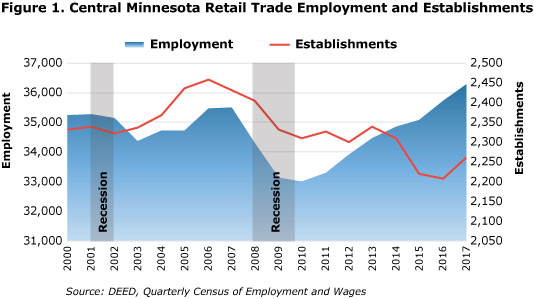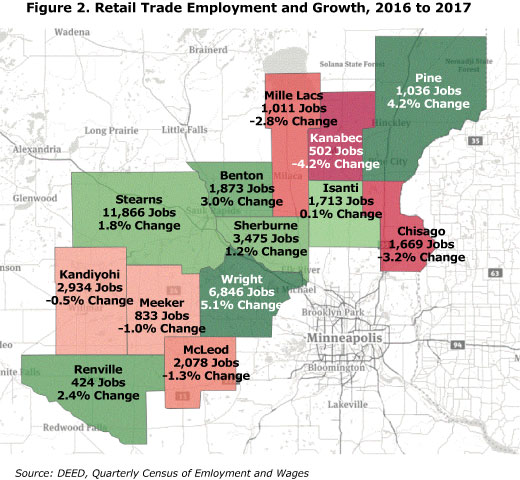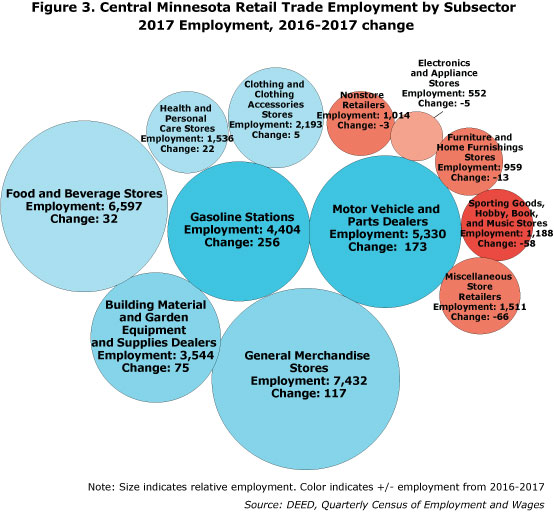
by Luke Greiner
June 2018
Bricks-and-mortar stores have been struggling nationwide, but retail employment is still growing in Central Minnesota.
Despite disruptive forces influencing the way consumers shop, Central Minnesota continues to add retail jobs. In stark contrast to empty storefronts and headlines announcing the struggles of major retailers, the region had record retail employment in 2017.
Retail trade tumbled during the Great Recession, shedding 7 percent of its workforce, about 2 points worse than the dip in the overall economy in Central Minnesota. Since bottoming out in 2010, however, retail trade has rebounded fast enough to replace all of the jobs lost during the recession and then some, adding 760 net new jobs (see Figure 1).

Still, retail’s recovery has been slower than overall economic growth in Central Minnesota, expanding 10 percent since 2010 compared with 12 percent for the region’s economy overall.
Noticeably, there are fewer retail trade establishments, possibly creating uneasiness about the future of the industry. Between 2010 and 2017, the retail sector lost 49 businesses, even while jobs were growing.
While not necessarily a trend, both retail employment and establishments in 2017 gained ground in Central Minnesota at a faster rate than any other region in the state, growing 1.5 percent and 2.4 percent, respectively.
Employment in the retail trade industry in the region ranged from 424 jobs in Renville County to 11,866 jobs in Stearns County in 2017.
Looking more closely at changes in the last year, job growth occurred in just seven of Central Minnesota’s 13 counties. Benton, Isanti, Pine, Renville, Sherburne, Stearns and Wright counties all had net job growth. Those counties added 692 retail jobs during that period. The six other counties in the region shed 158 jobs, giving the area a net gain of 534 jobs in the sector (see Figure 2).

In Central Minnesota, Wright County added the most retail trade jobs (up 333), enough to also have the fastest growth rate at 5.1 percent. Chisago County, in contrast, lost the most retail trade jobs (down 56). Kanabec actually had the largest percent decline (down 4.2 percent) with the loss of 22 of its 524 retail trade jobs from 2016 to 2017.
Counties with relatively low numbers of retail trade jobs like Renville and Kanabec are more influenced by small changes in employment. For instance, if Stearns County had lost the same number of retail jobs as Kanabec, the drop would have been only 0.2 percent.
Statewide changes in retail trade employment were similar, with a little over half of the counties gaining jobs and the remainder losing jobs.
Looking at the different types of retail businesses provides a more complete picture of recent changes. The largest-employing retail subsector is general merchandise stores, with 7,432 jobs in 2017. That subsector gained 117 jobs in the last year alone.
For the better part of a decade, general merchandise stores have been the largest-employing retail subsector in Central Minnesota. Employment at general merchandise stores has remained relatively constant since 2007, despite the recession. General merchandise stores include dollar stores, general stores, home and auto supply, superstores (food and dry goods) and warehouse stores.
Other subsectors with large payrolls include food and beverage stores (with nearly 6,600 jobs) and motor vehicle parts dealers (with over 5,300 jobs).
Together these three subsectors account for more than half of all retail trade jobs in Central Minnesota. Also notable is gasoline stations, which had the largest gain and the fastest growth in retail trade, adding 255 net new jobs last year, a 6.1 percent increase.
Recently, the largest retail trade subsectors added jobs while the smaller components like sporting goods stores, miscellaneous stores, furniture stores, and electronic and appliance stores shed jobs. The biggest loss of jobs was in miscellaneous retailers (down 66). That subsector includes florists, used merchandise stores, and pet and pet supply stores.
Although clothing stores gained a few jobs in the last year, the broader trend has been job loss since peaking in 2012. And while building material and supplies stores added a substantial number of jobs in the last year, the subsector still has 205 fewer jobs than in 2006 (see Figure 3).

Central Minnesota retailers posted 2,629 job openings in fourth quarter 2017, roughly the same as the record number posted in fourth quarter 2015.
Relatively low starting wages create a retention and recruitment challenge for employers. The median wage offer for all types of openings in the retail trade industry was just $11.68 in fourth quarter 2017, compared with $13.85 across all industries.
Fourth quarter saw a record number of job postings for retail salespeople and cashiers. Although the median wage offer for retail sales worker was only $10.07 per hour, these opportunities are heavily pursued by teenagers and others new to the job market. Twenty-two percent of jobs at retail trade establishments in the region were held by teenagers, who earned a median hourly wage of $9.88 in 2016.
Retail salesperson is the most common job in the sector, representing 28 percent of employment. Along with cashiers, those two occupations account for 46 percent of all jobs in the retail trade industry. They are typically visible and play a direct role with consumers, but the retail trade industry is more than just selling products and ringing them up.
Table 1 lists the 20 most common occupations within the retail trade industry and the estimated employment in the industry. The majority of jobs require no education past high school and have fairly low median wages. With a quarter of the jobs held by teenagers, the industry provides a place for many young workers to enter the labor market.
For workers who stay in retail trade, first-line supervisor is an attainable career goal. These jobs provide a livable wage of $18.25 per hour at the median, which is higher than the lowest wage needed to live independently in Central Minnesota for a typical family with one child. Similar pathways can be found in the material moving and logistics field, where packers and packagers earn a median wage of $11.45 but could gain enough skills to move into shipping, receiving and traffic clerks, where median wages jump to nearly $17 per hour.
The relatively few occupations in retail that require post-secondary education offer higher median wages. For instance, the estimated 459 general manager jobs in the sector have a median wage of $36.65 per hour, more than three times the median wage of retail salespersons.
| Table 1. Most Common Occupations in Retail Trade Industry in Central Minnesota | |||
|---|---|---|---|
| Occupation | Estimated Employment in Retail Trade Industry | Median Wage | Minimum Education Requirement |
| Retail Salespersons | 8,372 | $11.44 | High School Diploma or Less |
| Cashiers | 6,935 | $10.81 | High School Diploma or Less |
| Stock Clerks and Order Fillers | 3,596 | $11.78 | High School Diploma or Less |
| First-Line Supervisors of Retail Sales Workers | 1,978 | $18.25 | High School Diploma or Less |
| Automotive Service Technicians and Mechanics | 841 | $18.52 | Vocational Training |
| Laborers and Freight, Stock, and Material Movers, Hand | 823 | $15.53 | High School Diploma or Less |
| Combined Food Preparation and Serving Workers, Including Fast Food | 671 | $10.16 | High School Diploma or Less |
| Pharmacy Technicians | 611 | $16.31 | High School Diploma or Less |
| Parts Salespersons | 495 | $16.91 | High School Diploma or Less |
| Packers and Packagers, Hand | 473 | $11.45 | High School Diploma or Less |
| General and Operations Managers | 459 | $36.65 | Bachelor's Degree |
| Light Truck or Delivery Services Drivers | 414 | $15.98 | High School Diploma or Less |
| Customer Service Representatives | 372 | $15.41 | High School Diploma or Less |
| Pharmacists | 345 | $64.15 | Graduate Degree |
| Shipping, Receiving, and Traffic Clerks | 314 | $16.97 | High School Diploma or Less |
| Bookkeeping, Accounting, and Auditing Clerks | 295 | $18.62 | High School Diploma or Less |
| Butchers and Meat Cutters | 276 | $15.83 | High School Diploma or Less |
| Office Clerks, General | 264 | $16.70 | High School Diploma or Less |
| First-Line Supervisors of Office and Administrative Support Workers | 243 | $26.03 | High School Diploma or Less |
| Sales Managers | 202 | $46.07 | Bachelor's Degree |
| Source: DEED; OES, Occupational Staffing Pattern, Educational Requirements | |||
Are the wide range of opportunities in retail trade threatened by self-checkouts and online shopping? It's widely accepted that online shopping is putting pressure on local retailers, but the data do not point to the demise of retail yet. Instead, retail trade is poised to expand its payroll to record-breaking levels.
Employment projections for Central Minnesota's retail trade industry are positive, with expected growth of 6.8 percent from 2014 to 2024, an additional 2,400 jobs. As long as consumer confidence remains high and economic conditions allow, more workers will need to join the ranks of retail establishments in Central Minnesota.